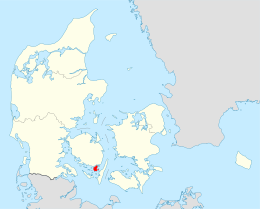Tåsinge

Valdemars Castle, the largest estate on the island
|
|
| Geography | |
|---|---|
| Location | Baltic Sea |
| Coordinates | 55°00′N 10°36′E / 55.000°N 10.600°E |
| Area | 70 km2 (27 sq mi) |
| Administration | |
|
Denmark
|
|
| Region | South Denmark Region |
| Municipality | Svendborg Municipality |
| Largest settlement | Vindeby (pop. 2,304) |
| Demographics | |
| Population | 6,187 (2010) |
| Pop. density | 88.4 /km2 (229 /sq mi) |
Tåsinge is a Danish island immediately south of Funen, opposite and facing Svendborg, divided from Funen by Svendborgsund. The island covers an area of circa 70 km2 (27 sq mi). It is part of the South Funen Archipelago and has 6.111 inhabitants. The Danish national road 9 crosses the island.
Until the municipality reform of 1970, the island retained its own municipality (sognekommune). Since 1970, it has been part of Svendborg Municipality.
Before the 1960s, when the island became connected to Funen via the Svendborgsund Bridge and to Langeland via the Langeland Bridge, it was served by ferries from Svendborg to Vindeby and from Vemmenæs to Rudkøbing respectively.
Until 2011 the public schools on the island consisted of two separate entities, Lundby Skole and Sundhøjskolen, but in 2011 they were merged into a single structure called Tåsingeskolen with close to 800 pupils, by far the largest school in the entire municipality.
The inhabitants of the island refer to themselves as Tøsinger. The local dialect called tåsingsk is still in use on the island, though not as common as in the past.
The meaning of the island's name (Tåsinge) has been a matter of debate throughout the past couple of hundred years. The Knýtlinga saga mentions as a place name "þórslundr" ('Thor's Grove') in its description of Denmark (chap. 32) and though it might refer to the island of Tåsinge, it could also well be referring to another place near Odense The first time Tåsinge clearly appears in the sources is in the Danish Census Book from around 1231, were it is called Thosland, and this designation seems to have been in proper use for a very long time, until the Age of Enlightenment, when antiquarians of the day because of the rudimentary state of etymology reinterpreted the name as 'Thorseng' or 'Thorsing', believing the name to mean 'Thors seng' or 'Thors eng' (lit. Thors bed/Thors meadow). This particular change in the island's name was seen in use for more than a century, until gradually it changed into the now used form.
...
Wikipedia

